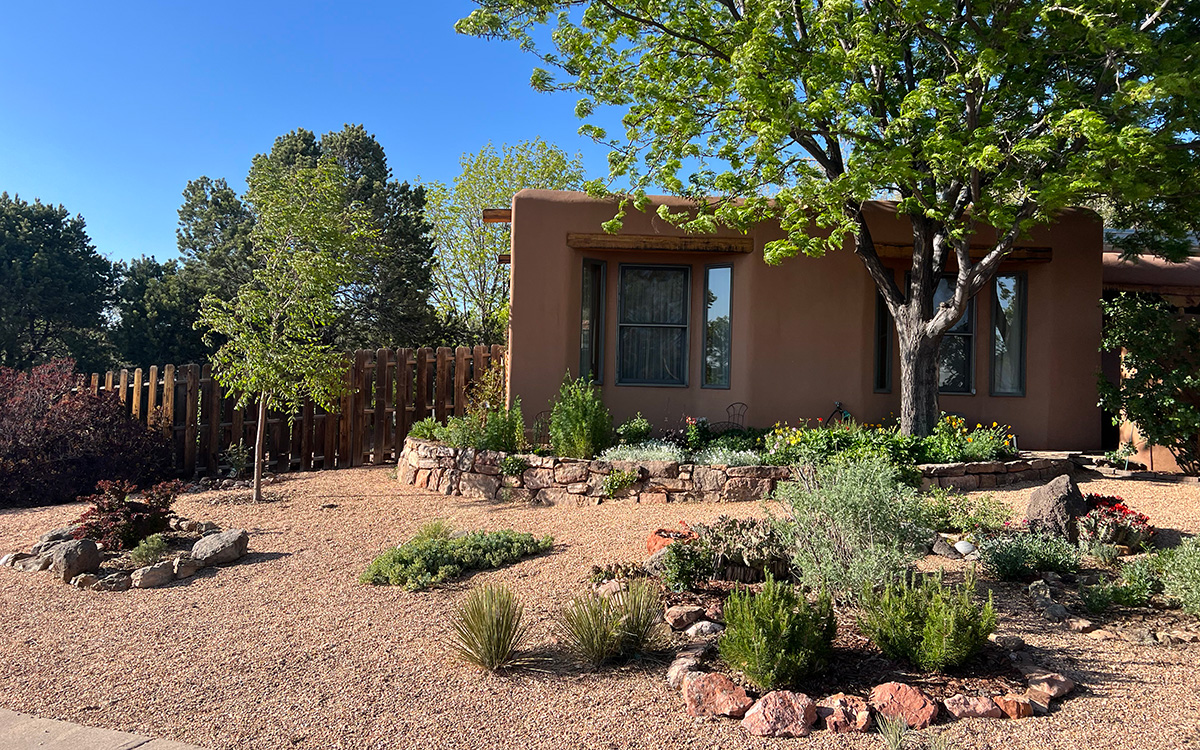
In How to Create a Garden with Curb Appeal in the Southwest, Part 1: Form, Flow, and Function, I discussed the importance of form (structures), flow (planting design), and function (how the space is used) in designing a front yard for maximum curb appeal. In this article, I’d like to go a little deeper in focusing on how planting design affects the function of the front yard.
Resist the urge to overplant
When deciding on your planting design in your front yard, it’s important to keep in mind that less is more. I’m a plant guy, so when I see a potential planting gap in the garden, my tendency is to fill it with a plant. We plant people need to have self-control and keep entryway plantings simple with a restrained plant palette. This creates a calm space that’s not overwhelming to viewers. More private areas of your property will naturally call for more attention and resources because these places tend to be where most people spend their time outdoors. Furthermore, a simple planting design enhances the function of the space. An entryway’s main function is to guide visitors toward the front door, front gate, or front driveway. The planting design should help to do this.

Your home is your home. What you like matters. Every property is different in aspects of size, scale, and topography. In my opinion, every entryway should be a little different. It’s boring to me to see every house in a row match. Doing nothing is also an option but not as rewarding, as seen in the above photograph. Below are some examples of planting design that have been executed well in order to create curb appeal.

A xeric hellstrip and shade trees create a welcoming entryway that doesn’t interfere with the driveway
The above property has a subtle flow and function. The front yard has open space defined by bedding edges. It features a rock garden and evergreens such as junipers (Juniperus spp. and cvs., Zones 2–9) and pines (Pinus spp. and cvs., Zones 2–9). There are also deciduous shade trees, which help keep this south-facing gravel heat island and the attached home cooler. This front yard is simple while having enough diversity to still be interesting. The garden bed is dividing two driveways with plants that require little to no irrigation. It has an open layout but is not too busy. The simplicity of the planting here allows for view corridors between driveways so as to avoid accidents, showing that the gardeners kept the function of the space in mind.

Low plantings and shade trees provide sightlines and shade along with color and texture contrast
This property features open space that flows into defined garden edges for a balanced effect. Plants with a variety of colors and textures bounce your eye through the yard. The open space between the clusters of plants keeps this landscape easy to maintain and water. Near an upper stone terrace near the home is where there is an abundance of color within a tight oasis zone that requires a medium amount of water. This terrace is also just under two main front windows to brighten the view looking out but not obstruct it. It also has cacti, rock gardens, and an evergreen palette of conifers. The prickly pear cactus creates color contrast with the juniper behind it and a smaller clump of cacti with red flowers in front of it. This flows into a low xeric planting near the driveway. The low habit of the plantings near the driveway makes it easy to maneuver into the driveway while seeing that there are no people or animals in the way.

There are also deciduous shade trees, which help shade this south-facing gravel heat island by keeping it cooler. The large tree near the home also casts shade on the house, helping to keep it cooler. This front yard is simple, while having enough diversity to still be interesting. There is also thought toward winter interest because of the evergreens, which are strategically planted.
At the end of the day, curb appeal is driven by your sensibilities, your priorities, and what appeals to you. Keep first impressions in mind and how your planting design impacts the function of the space.
—Mark Brotton, APLD, owns and operates Living Water, Irrigation, and Landscape based in Santa Fe, New Mexico.
Photos: Mark Brotton


















Comments
Log in or create an account to post a comment.
Sign up Log in